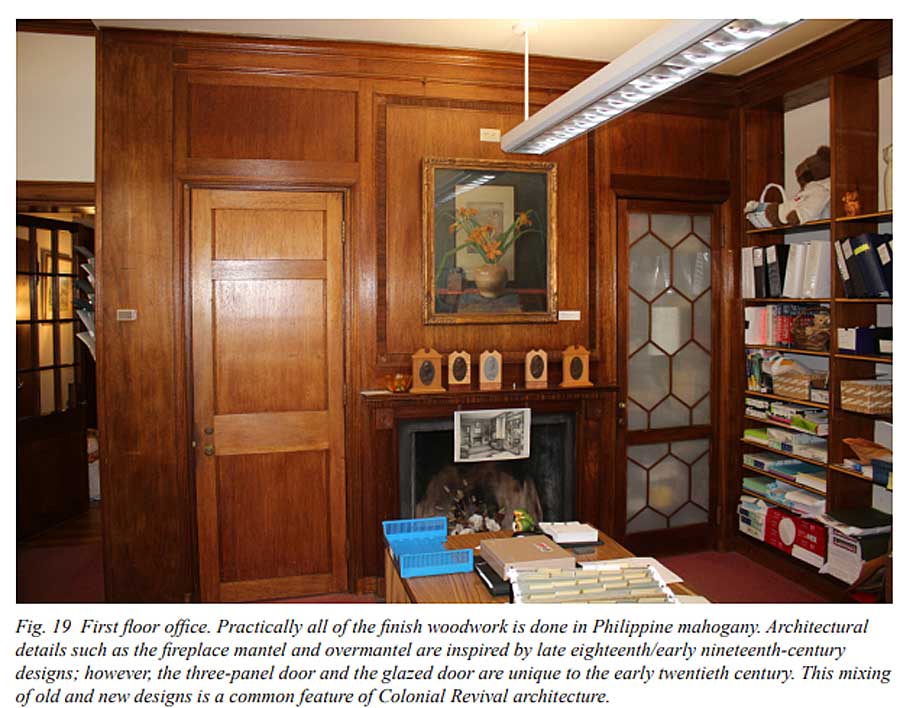Public Comment: A Better Plan Is Possible for Protecting the Historic Jones Library

The office of Charles Green, the first director of the Jones Library. The office is slated to be demolished in the planned Jones Library expansion. Photo: amherstma.gov
The following public comment was presented at the town’s Section 106 Review for the Jones Library demolition/expansion project, held on Zoom on October 10, 2024.
Those who developed the current plan knew, or should have known, about the Standards of the Secretary of the Interior, the Section 106 process, and MGL and Code of MA Regulations that protect historic properties. However, they chose NOT to comply with these regulations and put construction documents out to bid twice without having addressed them. The Massachusetts Board of Library Commissioners (MBLC) bears responsibility here as well, as they also disregarded state regulations to protect historic structures and threatened to rescind their funding if the plans were changed to comply with the rules. The inflexibility of a state grant process is not a sufficient or ethically conscionable reason to permit these adverse effects and cannot be allowed to dictate the approach to improving the Jones. A different plan can be developed and executed that both respects historic integrity and improves the experience of patrons and staff.
While adverse effects have finally been conceded, no genuine attempt has been made to either avoid or minimize them. Photographic documentation is not an acceptable “mitigation” measure. The loss of a quarter of the historic millwork, a figure that has yet to be explained, is unacceptable and avoidable. Furthermore, this library was designed to be experienced in a particular physical sense, the floor plan being central to that experience. Never during this process has there been a serious attempt to retain the floor plan and use creative measures to satisfy desirable updates. For example, the long sightlines currently in favor in modern building styles could be replaced with strategically located video cameras without knocking down multiple walls.
A gross overestimation of the user population has been the driving force behind the unnecessary expansion. A rethinking of the use of the nearly 50,000 square feet of the existing building could dramatically improve accessibility and functionality. Siting programming at branch libraries and existing town buildings would also obviate the need for the oversized and incongruent expansion, thereby avoiding the adverse effect of its massing and dominance over the historic building.
Buckingham slate IS still available and using it would avoid another adverse effect. If the exact shingles were not available, certainly another natural slate would be a far better choice than synthetic slate, thus minimizing the adverse effect.
There is certainly no need to cut a hole in the front of an historic building for a new book drop.
To date, well over 1,000 people have signed a petition calling for an end to the current project. Three out of 10 of them had previously supported it, but no longer do. Seven out of 10 cite the adverse effects on the historic Jones as a prime reason for their position. These signatories include a wide range of library users, from a young woman who moved to an apartment in town a few years ago and expressed shock and dismay at the lack of respect for an historic icon of town, to four generations of a family whose great grandfather actually worked on the construction of the 1928 building. To them, and many more, the historic Jones is more than just another building but a valued and unique representation of the town itself. The question now is whether this process will respect and reflect those same values.
This process must remain focused on the matter at hand: adverse effects of the historic integrity on the Jones. The primary problem is a design that features the destruction of a protected structure, including a large amount of irreplaceable historic materials, and a complete loss of the distinctive interior configuration that is integral to the historic Jones. Once gone, they are gone forever. But there is no NEED to destroy and dissemble this historic building, only the refusal of the project team to entertain an alternative plan that would respect the Jones’ inherent value and importance to the community. The town bylaws, historic restriction agreement, and federal and state standards and regulations exist to prevent just such losses. We are obligated to apply them faithfully.
Maria Kopicki is a resident of Amherst’s District 5 and a frequent contributor to the Indy.

Thanks Maria. I heard you at the meeting but you had to speak so quickly I missed how well thought out this is. There ARE other spaces in town, and the library COULD be reorganized to obtain more space, and programming could be put at the other libraries where it would be easier to park!